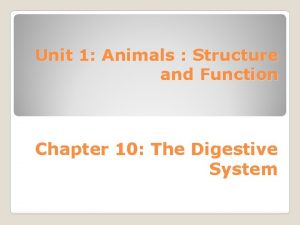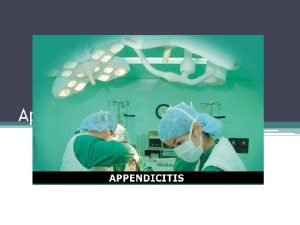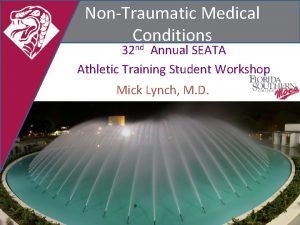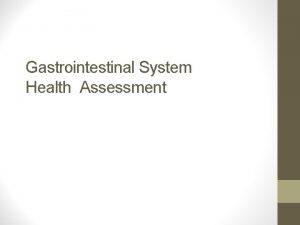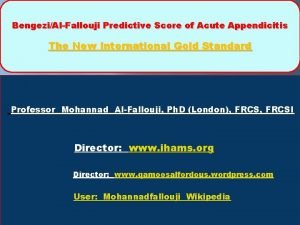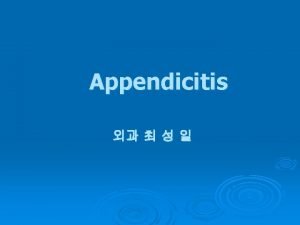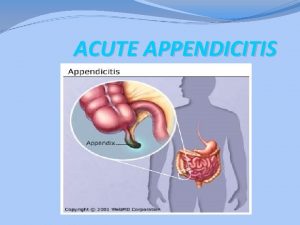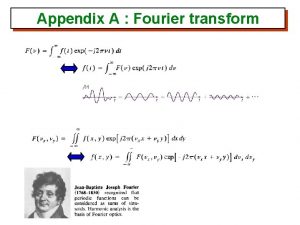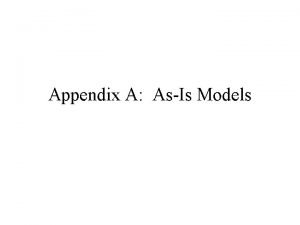Appendicitis Definition The appendix is a small fingerlike













- Slides: 13

Appendicitis

Definition • The appendix is a small, finger-like appendage attached to the cecum just below the ileo-cecal valve. • It empties into the colon inefficiently and its lumen is small; it is prone to becoming obstructed and is vulnerable to infection (appendicitis). • It is the most common cause of acute inflammation in RLQ of the abdominal cavity and the most common cause of emergency abdominal surgery.

Definition (cont’d) • Appendicitis results from obstruction, inflammation, and infection of the appendix. • Obstruction leads to hypoxia, leading to gangrene and/or perforation of the appendix. Perforation can result in the formation of an abscess and/or peritonitis. • Appendicitis is not preventable, therefore early detection is important.



Diagnostic Procedures and Nursing Interventions • Diagnosis is based on a complete physical examination and laboratory and imaging tests. • WBCs count and differential: (10, 000 to 18, 000/mm 3) , 20, 000/mm 3 may indicate peritonitis. • Abdominal US may show an enlarged appendix. • Abdominal CT may be diagnostic if symptoms are recurrent or prolonged. (Check allergies and renal function ? ? ? ) • Urinalysis • Pregnancy test, PID? ?

Therapeutic Procedures and Nursing Interventions • Surgical management includes an appendectomy : ▫ With laparoscope or ▫ an open approach

Assessments Monitor for signs and symptoms: ▫ Mild or cramping, epigastric or periumbilical pain (initial) ▫ Constant, intense RLQ pain (later) ▫ Rebound tenderness (pain after deep pressure is applied and released) over Mc. Burney’s point (located halfway between the umbilicus and anterior iliac spine) ▫ Pain that decreases with a decrease in right hip flexion or increases with coughing and movement may indicate perforation with peritonitis.

Clinical Manifestations • Low grade fever, nausea, and sometimes vomiting; • loss of appetite is common; constipation can occur. • At Mc. Burney’s point , local tenderness with pressure and some rigidity of the lower portion of the right rectus muscle. • Rovsing’s sign (palpating left lower quadrant, causes pain in right lower quadrant) • Muscle rigidity, tense positioning, guarding may indicate perforation with peritonitis. • If appendix ruptures, pain becomes more diffuse; abdominal distention develops from paralytic ileus, and condition worsens.

NANDA Nursing Diagnoses • Acute pain • Risk for infection • Risk for deficient fluid volume • Deficient knowledge • Anxiety

Nursing Interventions • Preoperative • Upon admission, maintain NPO status due to the possibility of emergency surgery. • Administer IV fluids as prescribed. • Encourage semi-Fowler’s position to contain abdominal drainage in the lower abdomen. • Avoid laxatives/enemas or application of heat to the abdomen, which could cause perforation.

Postoperative • Administer opioid analgesia (usually morphine sulfate) as ordered. • Administer IV antibiotics as ordered (surgical prophylaxis, perforation). • For peritonitis, monitor nasogastric (NG) tube drainage. • For perforation or abscess, monitor surgical drains.

Complications and Nursing Implications • Peritonitis due to perforation – Perforation is a lifethreatening emergency. • The risk of perforation is greatest 48 hr following the onset of appendicitis pain. • Carefully assess the client for: ▫ ▫ ▫ Fever of 38. 2° C or higher. Acutely ill appearance. Board-like abdomen Decreased urinary output. Septicemia. • Treatment includes administration of broad spectrum IV antibiotics. .
 Substrate feeder examples
Substrate feeder examples Definition of acute appendicitis
Definition of acute appendicitis Nursing interventions for appendicitis
Nursing interventions for appendicitis Appendicitis maneuvers
Appendicitis maneuvers Stomach quadrants and organs
Stomach quadrants and organs Appendicitis
Appendicitis Avogadro's score for appendicitis
Avogadro's score for appendicitis 5 stages of appendicitis
5 stages of appendicitis What is the pathophysiology of appendicitis?
What is the pathophysiology of appendicitis? Pathophysiology of appendicitis
Pathophysiology of appendicitis Appendix anatomy and physiology
Appendix anatomy and physiology Referred pain from appendicitis
Referred pain from appendicitis Catarrhal appendicitis
Catarrhal appendicitis Volkovich dyakonov
Volkovich dyakonov
